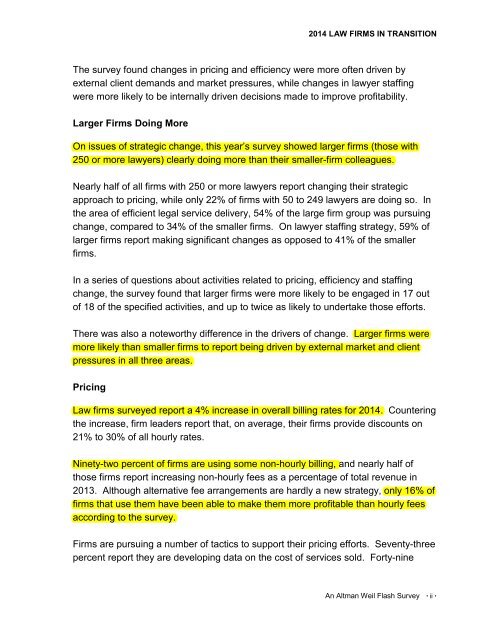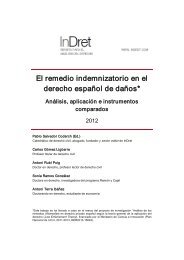MPF WHITE PAPER - AW 2014 Law Firms in Transition - 10-21-14
MPF WHITE PAPER - AW 2014 Law Firms in Transition - 10-21-14
MPF WHITE PAPER - AW 2014 Law Firms in Transition - 10-21-14
You also want an ePaper? Increase the reach of your titles
YUMPU automatically turns print PDFs into web optimized ePapers that Google loves.
<strong>20<strong>14</strong></strong> L<strong>AW</strong> FIRMS IN TRANSITIONThe survey found changes <strong>in</strong> pric<strong>in</strong>g and efficiency were more often driven byexternal client demands and market pressures, while changes <strong>in</strong> lawyer staff<strong>in</strong>gwere more likely to be <strong>in</strong>ternally driven decisions made to improve profitability.Larger <strong>Firms</strong> Do<strong>in</strong>g MoreOn issues of strategic change, this year’s survey showed larger firms (those with250 or more lawyers) clearly do<strong>in</strong>g more than their smaller-firm colleagues.Nearly half of all firms with 250 or more lawyers report chang<strong>in</strong>g their strategicapproach to pric<strong>in</strong>g, while only 22% of firms with 50 to 249 lawyers are do<strong>in</strong>g so. Inthe area of efficient legal service delivery, 54% of the large firm group was pursu<strong>in</strong>gchange, compared to 34% of the smaller firms. On lawyer staff<strong>in</strong>g strategy, 59% oflarger firms report mak<strong>in</strong>g significant changes as opposed to 41% of the smallerfirms.In a series of questions about activities related to pric<strong>in</strong>g, efficiency and staff<strong>in</strong>gchange, the survey found that larger firms were more likely to be engaged <strong>in</strong> 17 outof 18 of the specified activities, and up to twice as likely to undertake those efforts.There was also a noteworthy difference <strong>in</strong> the drivers of change. Larger firms weremore likely than smaller firms to report be<strong>in</strong>g driven by external market and clientpressures <strong>in</strong> all three areas.Pric<strong>in</strong>g<strong>Law</strong> firms surveyed report a 4% <strong>in</strong>crease <strong>in</strong> overall bill<strong>in</strong>g rates for <strong>20<strong>14</strong></strong>. Counter<strong>in</strong>gthe <strong>in</strong>crease, firm leaders report that, on average, their firms provide discounts on<strong>21</strong>% to 30% of all hourly rates.N<strong>in</strong>ety-two percent of firms are us<strong>in</strong>g some non-hourly bill<strong>in</strong>g, and nearly half ofthose firms report <strong>in</strong>creas<strong>in</strong>g non-hourly fees as a percentage of total revenue <strong>in</strong>2013. Although alternative fee arrangements are hardly a new strategy, only 16% offirms that use them have been able to make them more profitable than hourly feesaccord<strong>in</strong>g to the survey.<strong>Firms</strong> are pursu<strong>in</strong>g a number of tactics to support their pric<strong>in</strong>g efforts. Seventy-threepercent report they are develop<strong>in</strong>g data on the cost of services sold. Forty-n<strong>in</strong>eAn Altman Weil Flash Survey ii



